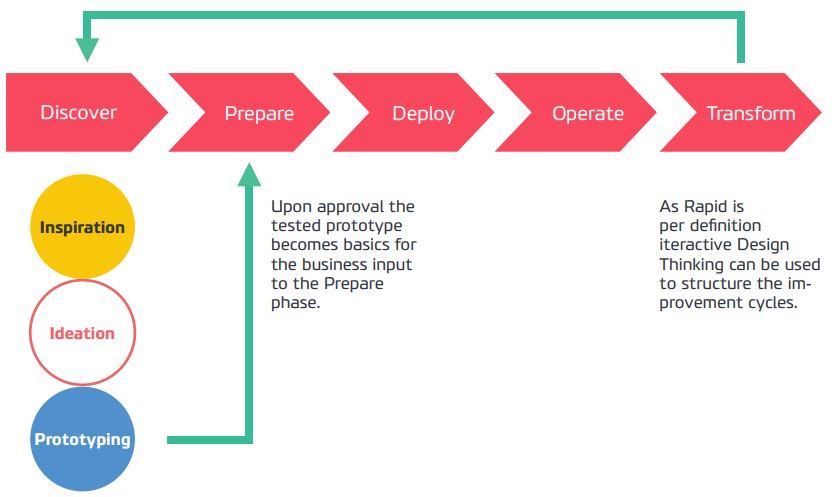As we have shown, these two methods, Design Thinking and Rapid Method, both support co-creation inherently, by directly involving key stakeholders in structured and creative processes. We have demonstrated how both methods are uniquely suited to implement (and re-implement) service management practices and concepts in their own right, and how the ITIL 4 dimensions and Guiding Principles can be easily superimposed on the implementation processes to ensure ITIL 4 alignment and service value orientation.
What if these two methods, which are considerably different in terms of strengths, could in fact complement each other?
Rapid Method shows an efficient way of speeding up implementation into a versatile and easily configurable tool like ServiceNow. Other platforms also suitable for this method could be Salesforce, Sitecore, Sharepoint or Microsoft XRM. However, they do not provide much in terms of creative exploration of the initial need. The tool has often already been chosen when Rapid is deployed, and as the starting point is the workshop participants’ needs and pains, which have already been dealt with, this puts up a natural barrier against the final result. Example: The workshop is brought together to consolidate incident management into one tool, Servicenow. A workshop put together this way makes it impossible to openly explore how future users will experience service on their IT when things break, or systems crash. To add this dimension, we need Design Thinking.
Design Thinking helps the workshop participants to break current mental boundaries and explore alternative solutions to a need, which can be independent of technology, data, visual brand, economy, language or even impossible. Design Thinking allows total freedom to imagine a perfect structure, concept, user experience or process, and can be modelled in any prototyping medium that the workshop facilitator sees fit. The problem is, of course, that once the service catalog has been modelled on brown paper with 575 post-its (low resolution, high fidelity), considerable work has to be done to make it fit into user stories, and it isn’t immediately obvious how it can be implemented. To bring the idea to life, and fast, we use Rapid Method.
The combined method is illustrated like this:

In this way, the structure of Design Thinking enhances the Discover phase of Rapid Method. The Facilitator of the Design Thinking workshop could guide the prototype quality towards a product that could go directly into the Prepare Phase. Alternatively, the Prepare Phase could be utilised to transform the prototype to user stories, or even a technology choice, with the help of, for example, Architects, vendors and product owners. Towards the end of the Rapid process, we can see that we have to iterate in the Transform phase, which can then tap into yet another cycle of Design Thinking, if necessary – or into an effective Discover phase, if the previous cycle’s choices still reflect current pains and needs.
ITIL4 underlines the need to focus consistently on the value provided by a service to consumers and customers. So, Co-creation with consumers and customers is the only way to lead the service value journey, and if we use co-creative, iterative methods to understand the need and developing service solutions, we can ensure maximum agility and, essentially, value.
